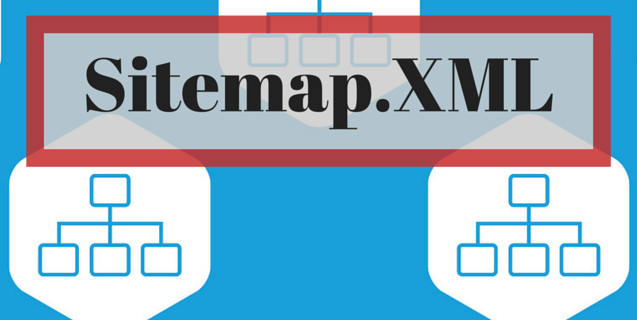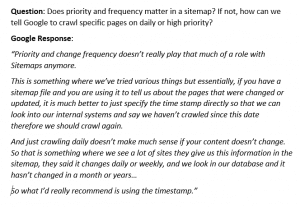
Sitemap.XML – Why Changefreq & Priority XML Are Important
If your website has an XML sitemap (and it should for indexing purposes according to our 2014 SEO Best Practice Audit Elements ), Changefreq and Priority are two important sitemap tags for supplying data to the search engines. They affect when and how often search engine “spiders” (also called “robots” or “crawlers”) visit your site’s individual pages, which has various implications.
Although using Changefreq and Priority XML sitemap tags is voluntary, they remain important for several reasons. Read on for a quick & handy outline of Google’s sitemap Priory & Changefreq guidelines…
Changefreq & Sitemap.XML Priority Settings
According to Google, the Changefreq XML tag may be set to one of seven frequencies:
- “never”
- “yearly”
- “monthly”
- “weekly”
- “daily”
- “hourly”
- “always”
This tells the search engines approximately how often each page is updated. An update refers to actual changes to the HTML code or text of the page, not updated Flash content or modified images.
Changefreq Guidelines & Examples
- NEVER: Old news stories, press releases, etc
- YEARLY: Contact, “About Us”, login, registration pages
- MONTHLY: FAQs, instructions, occasionally updated articles
- WEEKLY: Product info pages, website directories
- DAILY: Blog entry index, classifieds, small message board
- HOURLY: Major news site, weather information, forum
- ALWAYS: Stock market data, social bookmarking categories
Priority XML
The Priority XML sitemap tag is useful, although not quite as important. It is set to a number ranging from zero to one; if no number is assigned, a page’s priority is usually set to 0.5, however, this may vary depending on your exact site and plugin. A high priority page may be indexed more often and/or appear above other pages from the same site in search results.
Here are some examples of different types of pages and how their Priority sitemap XML tag value might be set, depending upon how important they are…
- 0.8-1.0: Homepage, subdomains, product info, major features, major category pages.
- 0.4-0.7: Articles and blog entries, minor category pages, sub-category pages, FAQs
- 0.0-0.3: Outdated news, info that has become irrelevant
NOTE: Changefreq & Priority XML for Large Sites
It’s important to point out that these settings are usually more important for larger websites. For smaller websites (let’s say, under 100 pages for the sake of the example), Google does a good job of figuring out relative content priorities and changes on its own. Being a smaller site, it is easy to crawl the content more frequently. Moreover, a small site (usually) has a simpler hierarchy, which makes it easier to interpret the relative priorities of any given page.
For large or very large sites (think thousands or hundreds of thousands of pages), however, the Changeqfreq & Priority XML tags become much more important. With so many pages, we want to do everything we can to help search engines understand and crawl our content. And these two tags are an excellent way to do this.
Will the Search Engines Abide by These Settings?
How strictly they want to follow the Priority and Changefreq sitemap specifications is up to the search engines; these XML tags are considered preferences, not orders. This doesn’t mean search engines don’t consider Priority and Changefreq important, just that they won’t put sitemap instructions before their own interests (like making sure a site hasn’t changed its subject or become pornographic).
But why is it important when or how frequently search engine “spiders” index your pages? When a “spider” visits a web page, it records information about the page’s content, title, META tags, links, and other characteristics. This ensures that search results reflect its latest content and take into account any recent improvements (such as new META tags or repaired links).
However, it is unnecessary for “spiders” to regularly scan pages that are seldom or never updated. Spider indexing consumes bandwidth (which can increase the cost of operating your website), and may briefly slow access to your site if it is run on a low-capacity server. Thus it is important to set the Changefreq sitemap tag to accurately reflect how often individual pages are updated.
So Now What?
Like we mentioned earlier, Changefreq and Priority settings are just a guide for Google, or any other search engine, to follow when indexing your site. Whether you have the capacity to do this on your own, or need a little help from a trusted expert, taking a deep dive into your overall site structure is highly recommended. Schedule an SEO Site Audit with Volume Nine today.
October, 2018 Update:
As Google has evolved the past few years, they have made a few important comments about how they prefer to handle Changefreq & Priority.XML tags in your Sitemap.XML file. In this 2015 Google Hangout webmaster chat, Google’s John Muller commented on the decreasing importance of these two tags.
Essentially, Google highlighted that one of the more modern items to really pay attention to is the timestamp for any given page. This helps inform Google when a page was last updated. One of the biggest things Google seems to care about is ensuring that they are able to easily see when / how often content is updated, and that you are consistent in how you tell them that. The timestamp is a great way to do this.
For our purposes, we still feel that Changefreq & Sitemap.XML Priority settings are another important way to do that (especially for larger sites – see the note below), provided you follow the best practices outlined in this post. And of course, in light of the new comments, keeping the timestamp updated for new changes will now be of utmost importance as well.
Here is the full Q&A from Google:








